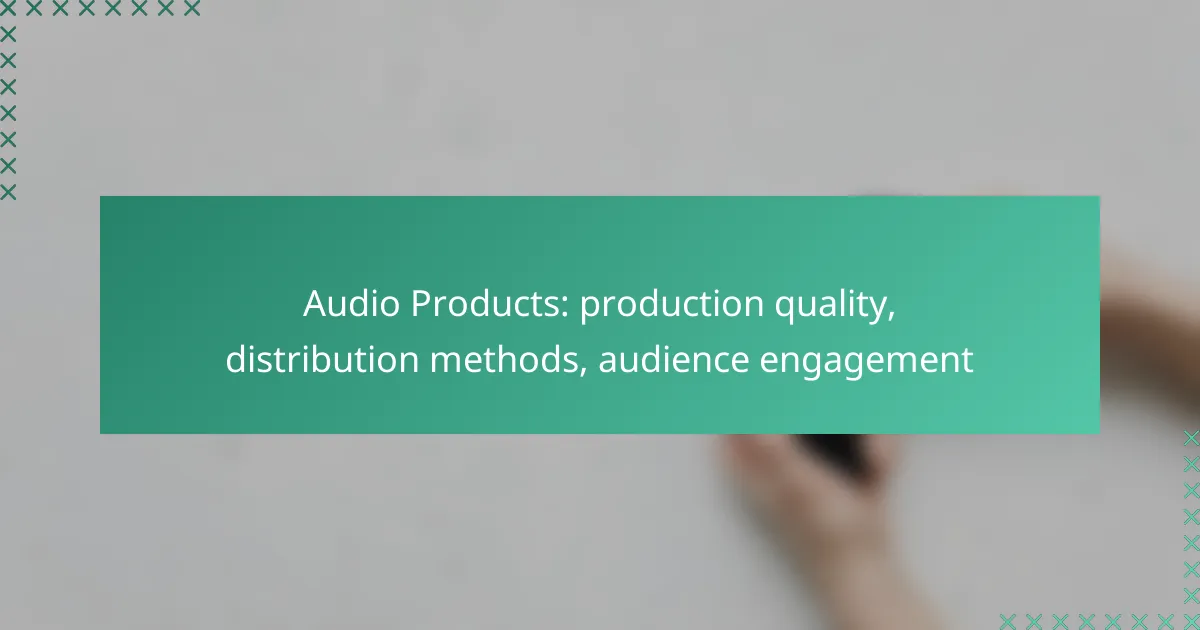In the competitive landscape of audio products, achieving high production quality is crucial for capturing listener attention. By utilizing top-notch equipment and professional software, creators can enhance the clarity and richness of their audio. Additionally, choosing the right distribution methods, such as streaming platforms and podcast hosting services, ensures that content reaches the intended audience effectively. Engaging listeners through interactive experiences and responsive feedback further strengthens the connection between creators and their audience.

How to improve audio production quality in Canada?
To enhance audio production quality in Canada, focus on using high-quality equipment, optimizing your recording environment, and employing professional software and services. These steps can significantly elevate the clarity and richness of your audio output.
Use high-quality microphones
Investing in high-quality microphones is essential for capturing clear and detailed sound. Look for condenser microphones for studio recordings and dynamic microphones for live settings. Brands like Shure and Audio-Technica offer reliable options that cater to various budgets.
Consider the microphone’s polar pattern, as it affects how sound is captured from different directions. For instance, cardioid patterns are great for isolating vocals, while omnidirectional mics can capture ambient sounds effectively.
Implement acoustic treatment
Acoustic treatment involves modifying your recording space to reduce unwanted sound reflections and echoes. Use sound-absorbing materials such as foam panels, bass traps, and carpets to create a more controlled environment. This can lead to clearer recordings without background noise interference.
Evaluate your space’s acoustics by listening for echoes or reverberations. Simple adjustments, like placing furniture strategically or using heavy curtains, can also help improve sound quality without a large investment.
Utilize digital audio workstations
Digital audio workstations (DAWs) are crucial for editing and mixing audio tracks. Popular options include Ableton Live, Pro Tools, and Logic Pro, each offering unique features suited for different types of projects. Choose a DAW that aligns with your workflow and the complexity of your audio production.
Familiarize yourself with the DAW’s tools for equalization, compression, and effects to enhance your recordings. Many DAWs offer tutorials and community forums that can help you learn how to maximize their capabilities.
Invest in professional mixing and mastering services
Professional mixing and mastering can significantly improve the final sound quality of your audio projects. Mixing balances the individual tracks, while mastering ensures they sound cohesive across various playback systems. Consider hiring experienced professionals who understand the nuances of audio production.
When selecting a mixing and mastering service, review their portfolio and client testimonials. This can help you gauge their expertise and ensure they align with your audio vision. Budget for these services, as they can vary widely in cost, often ranging from a few hundred to several thousand Canadian dollars depending on the complexity of your project.

What are effective distribution methods for audio products?
Effective distribution methods for audio products include utilizing streaming platforms, leveraging podcast hosting services, and distributing through digital marketplaces. Each method offers unique advantages and reaches different segments of the audience, making it essential to choose the right combination for your content.
Utilize streaming platforms like Spotify
Streaming platforms such as Spotify are crucial for reaching a broad audience. They allow creators to upload audio content easily and provide algorithms that help promote new releases to potential listeners. Consider creating playlists or collaborating with other artists to increase visibility.
To maximize engagement, focus on optimizing your profile with high-quality cover art and engaging descriptions. Regularly updating your content and promoting it on social media can also drive traffic to your Spotify page.
Leverage podcast hosting services
Podcast hosting services like Podbean or Anchor offer specialized tools for distributing audio content. These platforms provide analytics, monetization options, and easy integration with various directories, making it simple to reach listeners on platforms like Apple Podcasts and Google Podcasts.
When selecting a hosting service, consider factors such as storage limits, ease of use, and pricing. Regularly check your analytics to understand your audience better and tailor your content accordingly.
Distribute through digital marketplaces like iTunes
Digital marketplaces, including iTunes, enable creators to sell or distribute their audio products directly to consumers. This method can be particularly effective for music and audiobooks, allowing for direct revenue generation.
To succeed on these platforms, ensure your audio files meet the required quality standards and consider pricing strategies that reflect market trends. Regular promotions or exclusive releases can also attract more buyers and listeners.

How to engage audiences with audio content?
Engaging audiences with audio content involves creating compelling experiences that resonate with listeners. This can be achieved through interactive elements, effective promotion, and incorporating feedback to refine content.
Create interactive audio experiences
Interactive audio experiences allow listeners to engage actively rather than passively consuming content. Consider integrating features like quizzes, polls, or choose-your-own-adventure storytelling to enhance involvement.
Platforms such as Spotify and Apple Podcasts are increasingly supporting interactive features. For example, using embedded links or prompts within your audio can encourage listeners to explore related content or participate in discussions.
Utilize social media for promotion
Social media is a powerful tool for promoting audio content and reaching a broader audience. Share snippets or highlights from your audio to entice potential listeners, and use engaging visuals to accompany your posts.
Platforms like Instagram, Twitter, and TikTok can help you connect with your audience. Utilize hashtags relevant to your content and engage with followers through comments and direct messages to build a community around your audio offerings.
Incorporate listener feedback mechanisms
Incorporating listener feedback is crucial for improving audio content and fostering engagement. Encourage your audience to share their thoughts through surveys, comments, or social media interactions.
Consider using tools like Google Forms or dedicated feedback platforms to collect insights. Regularly review this feedback to identify trends and make adjustments that align with your audience’s preferences, ensuring your content remains relevant and engaging.

What criteria should be considered for audio product selection?
When selecting audio products, consider production quality, distribution methods, and audience engagement. These criteria ensure that the audio content meets listener expectations and achieves effective outreach.
Assess target audience preferences
Understanding your target audience’s preferences is crucial for audio product selection. Conduct surveys or focus groups to gather insights on their listening habits, preferred genres, and content formats.
Consider demographics such as age, location, and lifestyle, as these factors influence what your audience finds engaging. For instance, younger audiences may prefer podcasts, while older listeners might favor traditional radio shows.
Evaluate production budget
Your production budget significantly impacts the quality and scope of your audio products. Determine how much you can allocate for equipment, studio time, and post-production services.
Typically, a modest budget may range from a few hundred to a few thousand dollars, depending on the complexity of the project. Prioritize spending on high-quality microphones and editing software to enhance the overall production value.
Consider distribution reach
Distribution methods play a vital role in how widely your audio products are accessed. Evaluate platforms such as streaming services, podcast directories, and social media to maximize reach.
Choose distribution channels that align with your audience’s listening habits. For example, if your target audience frequently uses Spotify or Apple Podcasts, ensure your content is available on those platforms to enhance visibility and engagement.

What are the emerging trends in audio products?
Emerging trends in audio products include advancements in immersive audio experiences, the integration of artificial intelligence in production, and the growth of audio branding strategies. These trends are reshaping how audio content is created, distributed, and consumed, enhancing user engagement and experience.
Growth of immersive audio experiences
Immersive audio experiences are becoming increasingly popular, utilizing technologies like spatial audio and 3D sound to create a more engaging listening environment. This trend allows listeners to feel as if they are part of the audio scene, enhancing the emotional impact of music, podcasts, and other audio formats.
To implement immersive audio, creators should consider using platforms that support formats such as Dolby Atmos or DTS:X. These technologies can elevate production quality and attract audiences seeking richer experiences.
Increased use of AI in audio production
The use of artificial intelligence in audio production is on the rise, streamlining processes such as mixing, mastering, and even composing music. AI tools can analyze audio data to suggest improvements, automate repetitive tasks, and personalize content for listeners.
Producers should explore AI software options that can enhance their workflow, but they should remain mindful of the balance between automation and human creativity. Relying too heavily on AI may lead to a loss of unique artistic expression.
Expansion of audio branding strategies
Audio branding is gaining traction as businesses recognize the power of sound in shaping brand identity. Companies are increasingly using jingles, sound logos, and tailored audio content to create memorable associations with their brands.
To effectively implement audio branding, businesses should focus on consistency across all audio touchpoints, such as advertisements, podcasts, and customer service interactions. This strategy can significantly enhance brand recognition and customer loyalty.
